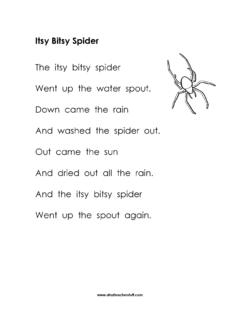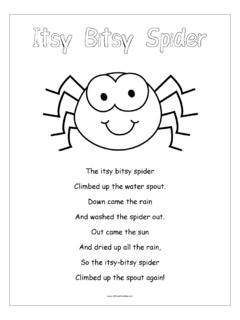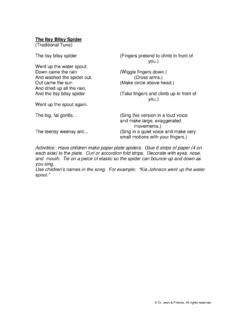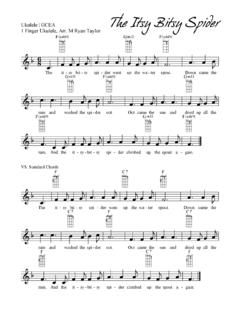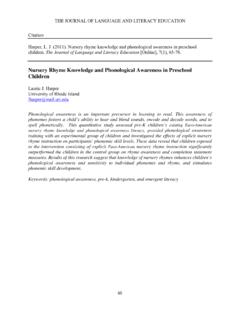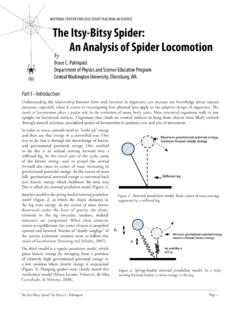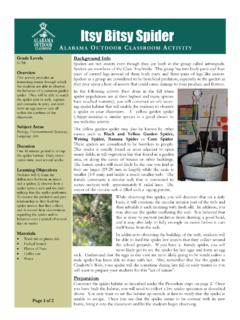Transcription of Consult 4 Kids Lesson Plans - True North Americorps
1 Consult 4 kids Lesson Plans Opening State the objective Retelling a story begins at the beginning and detail by detail makes its way to the end. The objective of this Lesson is to give Kindergartners-2nd graders an opportunity practicing retelling a story. Gain prior knowledge by asking students, Retelling (Kindergarten-2nd grade) What does it mean to retell something? (start at the beginning and tell the story to the end) When you think of the story The Three Bears, what do you think are the most important details (bears go for a walk, Goldilocks eats the porridge, breaks the chair, goes to sleep in the baby bear s bed, wakes up and sees the bears looking at her, runs away) List these important details as students give them (not in chronological order) When retelling a story it is helpful to the person listening to hear the events in order.
2 Let s organize the events above in the order in which they happened. This is called chronological or time order. Information for you: Retelling is simply that, using your own words to tell the story. A retell of the story would begin with Once upon a time and go through detail by detail until the end of the story is reached. The goal is for youth to retell across the entire story, or paragraphs or It is important that retellers understand that they should retell the story in order. K/1 students are not developmentally ready to summarize. However, they can retell events that happened in the story, and put these events in the correct sequence. Later, they will have a place in their thinking process to hang their new skill of summarizing. Content (the Meat ) Grade Level: Kindergarten 2nd Grades Lesson Title: Itsy bitsy spider 1 H Focus: English Language Arts: Retelling Materials: Itsy bitsy spider written on a chart Consult 4 kids Lesson Plans Instruction / Demonstration ( I do We do ) You will guide this entire retell Lesson .
3 The Itsy bitsy spider : This is a Kinder-2nd grade Retell Lesson . The itsy bitsy spider went up the water spout. Down came the rain and washed the spider out. Out came the sun and dried upon the rain, And the itsy bitsy spider went up the spout again. 1. Write the rhyme on the white board. 2. Practice reading the rhyme. 3. Divide students into four groups. 4. Choose a student leader for each group. 5. Assign each group a line in the rhyme. 6. Student leaders lead their group to read their line in the rhyme 7. Practice two or three times. 8. Add hand motions to the rhyme. 9. Student leaders lead their group including hand motions. 10. Erase the poem from the white board. 11. Draw four large picture frames on the white board. 12. Ask students which line comes first in the rhyme.
4 13. Ask a student to draw a picture in Frame 1 of the spider going up the water spout. 14. Repeat the process until there are four frames illustrating the rhyme. 15. Ask students what would happen if we put the picture frames out of order. 16. Why is sequencing important in a story? 17. Erase the picture frames. 18. Without the pictures, can anyone retell the rhyme? *Activity Teachable Moment(s) throughout When you are intentionally teaching the skill of retelling, take the time to point out the many times during each day that retelling what has just happened makes thinking about things or situations easier. The ability to retell helps to keep us focused on the key learning. Stop to help students understand how to ensure that they are on target. Take time to stop the class and ask them to retell for a partner.
5 Check in often to see if they have ideas for making the Lesson more fun and enjoyable. Listen for how and what questions. Ask students to explain what is going on in a brief retell. Closing Review Say: Please recap what we did today. Did we achieve our objectives? Debrief DIGA Describe, Interpret, Generalize, Apply Ask the children the following four questions: 1. What did we do today? Describe 2. What skills did you use? Interpret 3. How did you feel about what we did today? Generalize 4. How will you apply these skills tomorrow? Apply Consult 4 kids Lesson Plans Modifications Reflection (Confirm, Tweak, Aha!) Ask students to think about what they did today in English/Language Arts. Ask them to comment on what they did today was something they already knew how to do.
6 (Confirmation) Ask them to comment on what they did today that was like something they had done before except in one particular way which was new to them. (Tweak) Ask them to comment on something (if anything) they have learned today that was brand new to them.


